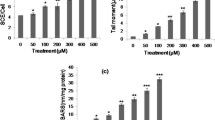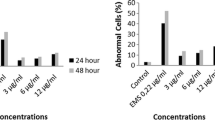Abstract
Most of the biological, chemical or physical agents that cause cell death in certain doses and time of exposure may induce either apoptosis or necrosis. This study explores in what ways the genotoxic, cytotoxic and apoptotic effects of diethylstilbestrol (DES), a chemical agent currently used in the treatment of various types of cancer, on the human lymphocytes depend upon the dose and the exposure time. For this purpose, firstly it aims to determine in what dosages and durations of DES treatment, genotoxicity and cytotoxicity in human lymphocytes occur in vitro. Secondly, it explores the effects of DES on sister-chromatid exchanges (SCEs) and apoptosis and their relation with the nitric oxide (NO) levels. Finally, it investigates whether different dosages of DES and duration of treatment with it are correlated with each other. In so doing, we investigated the relationship among the viability, necrosis and apoptosis rates of human lymphocytes which were treated with five different DES concentrations (1, 5, 10, 15 and 20 μM) for 24, 48 and 72 h, DNA fragmentation analysis of these cells, their mean SCE values and NO levels. We concluded that 5 μM DES at 24 h is the most effective dosage that induces typical features of apoptosis in human lymphocytes. Despite the fact that there are many other studies on the effects of DES on the cancer cells, we thought it might be worth looking into the effects of DES on human lymphocytes in vitro. We meant the present study to contribute to the research done in the field of cancer treatment. (Mol Cell Biochem 276: 45–53, 2005)
Similar content being viewed by others
Abbreviations
- AO/EtBr:
-
acridine orange/ethidium bromide
- DES:
-
diethylstilbestrol
- NO:
-
nitric oxide
- SCEs:
-
sister-chromatid exchanges
References
Bennink Coelingh HJT: Are all estrogens the same? Maturitas 47: 269–275, 2004
Marselos M, Tomatis L: Diethylstilbestrol: I. Pharmacology, toxicology and carcinogenicity in humans. Eur J Cancer 28A: 1182–1189, 1992
Herbst AL, Ulfelder H, Poskanzer DC: Adenocarcinoma of the vagina: Association of the maternal stilbestrol therapy with tumor appearance in young women. New Engl J Med 284: 878–881, 1971
Degen GH, Bolt HM: Endocrine disruptors: Update on xenoestrogens. Int Arch Occup Environ Health 73: 433–441, 2000
Banduhn N, Obe G: Mutagenicity of methyl 2-benzimidazolecarbamate, diethylstilbestrol and estradiol: Structural chromosomal aberrations, sister-chromatid exchanges, C-mitoses, polyploidies and micronuclei. Mutat Res-Gen Toxicol 156(3): 199–218, 1985
Sharma RK, Jacobson-Kram D, Lemmon M, Bakke J, Galperin I, Blazak WF: Sister-chromatid exchange and cell replication kinetics in fetal and maternal cells after treatment with chemical teratogens. Mutat Res-Gen Toxicol 158(3): 217–231, 1985
Schuler M, Hasegawa L, Parks R, Metzler M, Eastmond DA: Dose-response studies of the induction of hyperdiploidy and polyploidy by diethylstilbestrol and 17 beta-estradiol in cultured human lymphocytes using multicolor fluorescence in situ hybridization. Environ Mol Mutagen 31(3): 263–73, 1998
Cox R, Crawford E: Estrogens in the treatment of prostate cancer. J Urol 154: 1991–1998, 1995
Calemine JB, Gogal RM, Lengi A, Sponenberg P, Ahmed SA: Immunomodulation by diethylstilbestrol is dose and gender related: effects on thymocyte apoptosis and mitogen-induced proliferation. Toxicol 178: 101–118, 2002
Scherr D, Pitts WR, Vaughan ED: Diethylstilbestrol revisited: Androgen deprivation, osteoporosis and prostate cancer. J Urol 167: 535–538, 2002
Kerr JF, Wyllie AH, Currie AR: Apoptosis: A basic biological phenomenon with wide-ranging implication in tissue kinetics. Br J Cancer 26: 239–257, 1972
Robertson CN, Roberson KM, Padillla GM, O’Brien ET, Cook JM, Kim CS, Fine RL: Induction of apoptosis by diethylstilbestrol in hormone-insensitive prostate cancer cells. J Natl Cancer Inst 88(13): 908–917, 1996
Guo C, Yu S, Davis AT, Wang H, Green JE, Ahmed K: A potential role of nuclear matrix-associated protein kinase CK2 in protection against drug-induced apoptosis in cancer cells. J Biol Chem 276(8): 5992–5999, 2001
Qui CH, Ohe M, Koibuchi N, Matsuzaki S: Apoptosis in the epididymal epithelium of adult male golden hamster exposed to diethylstilbestrol. J Histochem Cytochem 52(2): 187–192, 2004
Bursch W, Liehr JG, Sirbasku DA, Putz B, Taper H, Schulte-Hermann R: Control of cell Death (apoptosis) by diethylstilbestrol in an estrogen-dependent kidney tumor. Carcinogenesis 12(5): 855–860, 1991
Nair R, Shaha C: Diethylstilbestrol Induces Rat Spermatogenic Cell Apoptosis in vivo through increased expression of spermatogenic cell Fas/FasL system. J Biol Chem 278(8): 6470–6481, 2003
Lai ZW, Fiore CN, Hahn PJ, Gasiewicz TA, Silverstone AE: Differential effects of diethylstilbestrol and 2, 3, 7, 8-tetrachlorodibenzo-p-dioxin on thymocyte differentiation, proliferation and apoptosis in bcl-2 trangenic mouse fetal thymus organ culture. Toxicol Appl Pharm 168: 15–24, 2000
Tomimori Y, Ikawa Y, Oyaizu N: Ultraviolet-irradiated apoptotic lymphocytes produce interleukin-10 by themselves. Immunol Lett 71(1): 49–54, 2000
Devadas S, Hinshaw JA, Zaritskaya L, Williams MS: Fas-stimulated generation of reactive oxygen species or exogenous oxidative stress sensitize cells to Fas-mediated apoptosis. Free Radic Biol Med 35(6): 648–661, 2003
Buzard GS, Kasprzak KS: Possible roles nitric oxide and redox cell signaling in toxicity and carcinogenesis: a review. J Environ Pathol Toxicol Oncol 19: 179–199, 2000
Roger R, Issaad C, Pallardy M, Leglise MC, Turhan AG, Bertoglio J, Breard J: BCR-ABL does not prevent apoptotic death induced by human natural killer or lymphocyte-activated killer cells. Blood 87: 1113–1117, 1996
Gong JP, Traganos F, Darzynkiewicz Z: A selective procedure for DNA extraction from apoptotic cells applicable for gel electrophoresis and flow cytometry. Anal Biochem 218(2): 314–319, 1994
Perry P, Wolff S: New Giemsa method for the differential staining of sister chromatids. Nature 258: 156–158, 1977
Braman RS, Hendrix SA: Nanogram nitrite and nitrate determination in environmental and biological materials by vanadium (III) reduction with chemiluminescence detection. Anal Chem 61: 2715–2718, 1989
Bratton SB, Cohen GM: Apoptotic death sensor: an organelle’s alter ego? Trends Pharmacol Sci 22: 306–315, 2001
Clarke AR, Purdie CA, Harrison DJ, Morris RG, Bird CC, Hooper ML, Wyllie AH: Thymocyte apoptosis induced by p53-dependent and independent pathways. Nature 362: 849–852, 1993
Ritke MK, Rusnak JM, Lazo JS, Allan WP, Dive C, Heer S, Yalowich JC: Differential induction of etoposide-mediated apoptosis in human leukemia HL-60 and K-562 cells. Mol Pharmacol 46: 605–611, 1994
Ergun MA, Konac E, Erbas D, Ekmekci A: Apoptosis and nitric oxide release induced by thalidomide, gossypol and dexamethasone in cultured human chronic myelogenous leukemic K-562 cells. Cell Biol Int 28: 237–242, 2004
Yang J, Duerksen-Hughes P: A new approach to identifying genotoxic carcinogens: p53 induction as an indicator of genotoxic damage. Carcinogenesis 19(6): 1117–1125, 1998
Smith DC, Redman BG, Flaherty LE, Li L, Strawderman M, Pienta KJ.: A Phase II trial of oral diethylstilbestrol as a second-line hormonal agent in advanced prostate cancer. Urology 52: 257–260, 1998
Ahmed M, Choksy S, Chilton CP, Munson KW, Williams JH: High dose intravenous oestrogen (fosfestrol) in the treatment of symptomatic, metastatic, hormone-refractory carcinoma of the prostate. Int Urol Nephrol 30: 159–164, 1998
de Voogt HJ, Smith PH, Pavone-Macaluso M, de Pauw M, Suciu S: Cardiovascular side effects of diethylstilbestrol, cyproterone acetate, medroxyprogesterone acetate and estramustine phosphate used for the treatment of advanced prostatic cancer: Results from European Organization for Research on Treatment of Cancer Trials 30761 and 30762. J Urol 135: 303–307, 1986
Ham JM, Pirola RC, Crouch RL: Hemangioendothelial sarcoma of the liver associated with long-term estrogen therapy in a man. Dig Dis Sci 25: 879–883, 1980
Brooks JJ: Hepatoma associated with diethylstilbestrol therapy for prostatic carcinoma. J Urol 128: 1044–1045, 1982
Carmichael PL, Mills JJ, Campbell M, Basu M, Caldwell J: Mechanisms of hormonal carcinogenesis in the p53+/− hemizygous knockout mouse: Studies with diethylstilbestrol. Toxicol Pathol 29: 155–160, 2001
Marselos M, Tomatis L: Diethylstilbestrol II. Pharmacology, toxicology and carcinogenicity in humans. Eur J Cancer 29: 1182–1189, 1993
Fluckiger-Isler S, Baumeister M, Braun K, Gervais V, Hasler-Nguyen N, Reimann R, Van Gompel J, Wunderlich HG, Engelhardt G: Assessment of the performance of the Ames IITMassay: A collaborative study with 19 coded compounds. Mutat Res-Gen Toxicol Eng 558(1–2): 181–197, 2004
Dreher D, Junod AF: Role of oxygen free radicals in cancer development. Eur J Cancer 32A(1): 30–38, 1996
Igney FH, Krammer PH: Death and anti-death: Tumor resistance to apoptosis. Nature 2: 277–288, 2002
Kolb JP: Mechanisms involved in the pro- and anti-apoptotic effects of NO in human leukemia. Leukemia 14: 1685–1694, 2000
Zhang WY, Gotoh T, Oyadomaria S, Mori M: Coinduction of inducible nitric oxide synthase and arginine recycling enzymes in cytokine-stimulated PC12 cells and high output production of nitric oxide. Mol Brain Res 83: 1–8, 2000
Mannick JB, Miao XQ, Stamler JS: Nitric oxide inhibits Fas-induced apoptosis. J Biol Chem 272(39): 24125–24128, 1997
Sciorati C, Rovere P, Ferrarini M, Heltai S, Manfredi AA, Clementi E: Autocrine nitric oxide modulates CD95-induced apoptosis in gammadelta T lymphocytes. J Biol Chem 272(37): 23211–23215, 1997
Albina JE, Cui S, Mateo RB, Reichner JS: Nitric oxide-mediated apoptosis in murine peritoneal macrophages. J Immunol 150: 5080–5085, 1993
Kaneto H, Fujii J, Seo HG, Suzuki K, Matsuoka T, Nakamura M, Tatsumi H, Yamasaki Y, Kamada T, Taniguchi N: Apoptotic cell death triggered by nitric oxide in pancreatic beta-cells. Diabetes 44(7): 733–738, 1995
Valenti L, Mathieu J, Chancerelle Y, Levacher M, Chanaud B, De Sousa M, Strzalko S, Dinh-Xuan AT, Giroud JP, Florentin I: Nitric oxide inhibits spleen cell proliferative response after burn injury by inducing cytostasis, apoptosis and necrosis of activated T lymphocytes: Role of the guanylate cyclase. Cell Immunol 221: 50–63, 2003
Brune B, Von Knethen A, Sandau KB: Nitric oxide and its role in apoptosis. Eur J Pharmacol 351: 172–261, 1998
Joshi MS, Ponthier JL, Lancaster JR: Cellular antioxidant and pro-oxidant actions of nitric oxide. Free Radical Bio Med 27: 1357–1366, 1999
Bonfoco E, Krainc D, Ankarcron M, Nicotera P, Lipton SA: Apoptosis and necrosis: Two distinct events induced, respectively, by mild and intense insults with N-methyl-D-aspartate or nitric oxide/superoxide in cortical cell cultures. Proc Natl Acad Sci 92: 7162–7166, 1995
Author information
Authors and Affiliations
Corresponding author
Rights and permissions
About this article
Cite this article
Konac, E., Ekmekci, A., Barkar, V. et al. Effects of diethylstilbestrol in human lymphocytes in vitro: A dose and time-dependent study on genotoxic, cytotoxic and apoptotic effects. Mol Cell Biochem 276, 45–53 (2005). https://doi.org/10.1007/s11010-005-2815-8
Received:
Accepted:
Issue Date:
DOI: https://doi.org/10.1007/s11010-005-2815-8




